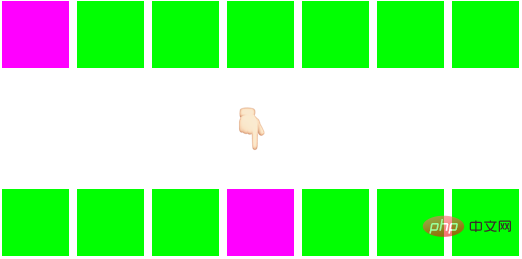Quickly master java sorting algorithm - quick sort (picture and text)

Concept
Quick sorting is an exchange sort. The main step is to use the reference element for comparison, and sort the elements that are smaller than the reference element. The ones that are larger than the base element move to one side, and the ones that are larger than the base element move to the other side. Thus, the array is divided into two parts, and then the reference elements are selected from the two parts and the above steps are repeated. The process is as follows:
(Recommended video: java video tutorial)
Purple: base element
Green: greater than base element
Yellow: less than Baseline elements

#This idea is called divide and conquer.
Basic elements
The selection of datum elements can be randomly selected. In the following use, I will use the first element as the base element.
Sort process
The sorting and splitting process is as shown below:
Purple is the base element, (re-selected in each round)
Green is other elements
First round
Second round
Third round
As shown in the figure above:
If the number of elements is n, because the sorting process needs to be compared with all elements, the time complexity is O(n),
On average, sorting rounds require logn rounds, so the average time complexity of quick sort is O(nlogn).
The implementation method of sorting
The implementation methods include bilateral circulation method and unilateral circulation method
Bilateral circulation method
The first choice is to select the pivot element (pivot) 4, and set the pointers left and right to point to the leftmost and rightmost elements of the array, as follows: 
First In this loop, first start with the data pointed to by the right pointer (rightData) and compare it with the base element.
If rightData >= pivot, the right pointer moves to the left. If rightData The data pointed by the left pointer (leftData) is compared with the reference element. If leftData pivot, the elements pointed to by left and right are exchanged.
After the first round of pointer movement, the following structure is obtained:

Then the elements pointed to by left and right are exchanged:

The first round of loop ends, switch to the right pointer again, and repeat the above steps.
After the second cycle, we get:

After the third round, we get:

After the fourth cycle, we get:

It is judged that the left and right pointers point to the same element, the pointers stop moving, and the pivot and pointer elements are exchanged, we get:

Declares the end of the cycle and divides it into two parts according to the Pivot element. The arrays of these two parts are then operated according to the above steps.
Implementation code
public class DoubleSort {
public static void quickSort(int[] arr, int startIndex, int endIndex) {
//递归结束条件
if (startIndex >= endIndex) {
return;
}
// 基准元素位置
int pivotIndex = partition(arr, startIndex, endIndex);
// 根据基准元素,分成两部分进行递归排序
quickSort(arr, startIndex, pivotIndex - 1);
quickSort(arr, pivotIndex + 1, endIndex);
}
public static int partition(int[] arr, int startIndex, int endIndex) {
// 取第一个元素为基准元素,也可以随机抽取
int pivot = arr[startIndex];
int left = startIndex;
int right = endIndex;
while (left != right) {
// 控制right指针比较并左移
while (left = pivot) {
right--;
}
// 控制left指针比较并右移
while (left <p id="单边循环法" style="white-space: normal;"><strong>Unilateral loop method</strong></p><p>Bilateral loop method compares and exchanges elements from both sides of the array, and The one-sided loop rule traverses from one side of the array and compares and exchanges backwards, making it easier to implement. <br>The process is as follows: </p><blockquote><p>Firstly, the pivot element is selected (can be selected randomly) <br>Set a mark pointer to point to the starting position of the array, representing the area boundary that is smaller than the baseline element (don’t understand Just understand it as being used to exchange elements later) </p></blockquote><p>The original array is as follows: </p><p><img src="/static/imghw/default1.png" data-src="https://img.php.cn/upload/article/000/000/040/b739c5c8ed7df91b0c77a8fae57a6150-11.jpg" class="lazy" alt="Quickly master java sorting algorithm - quick sort (picture and text)"></p><blockquote><p>从基准元素下一位开始遍历数组<br>如果该元素大于基准元素,继续往下遍历<br>如果该元素小于基准元素,mark指针往右移,因为小于基准元素的区域边界增大了1(即小于基准元素的多了1位),所以mark就 +1,并且该元素和mark指向元素进行交换。</p></blockquote><p>遍历到元素3时,因为3 </p><p><img src="/static/imghw/default1.png" data-src="https://img.php.cn/upload/article/000/000/040/baca0480a2a4ba4850e39cd5916f2819-12.jpg" class="lazy" alt="Quickly master java sorting algorithm - quick sort (picture and text)"></p><p>然后交换元素</p><p><img src="/static/imghw/default1.png" data-src="https://img.php.cn/upload/article/000/000/040/baca0480a2a4ba4850e39cd5916f2819-13.jpg" class="lazy" alt="Quickly master java sorting algorithm - quick sort (picture and text)"></p><p>然后就继续遍历,根据上面的步骤进行判断,后面的过程就不写了。</p><p id="实现代码-1" style="max-width:90%"><strong>实现代码</strong></p><pre class="brush:php;toolbar:false">public class SingleSort {
public static void quickSort(int[] arr, int startIndex, int endIndex) {
//递归结束条件
if (startIndex >= endIndex) {
return;
}
// 基准元素位置
int pivotIndex = partition(arr, startIndex, endIndex);
// 根据基准元素,分成两部分进行递归排序
quickSort(arr, startIndex, pivotIndex - 1);
quickSort(arr, pivotIndex + 1, endIndex);
}
/**
* 分治(单边循环法)
* @param arr
* @param startIndex
* @param endIndex
* @return
*/
public static int partition(int[] arr, int startIndex, int endIndex) {
// 取第一个元素为基准元素,也可以随机抽取
int pivot = arr[startIndex];
int mark = startIndex;
for(int i = startIndex + 1; i<p id="总结" style="white-space: normal;"><strong>总结</strong></p><p>本人也是初次接触算法,慢慢的去理解算法的思路和实现过程后,真是为自己以往写的算法感到羞愧。该文章也是为了加深自己对快排算法的印象,若文章有不足之处,恳请各位在下方留言补充。感谢各位的阅读。Thanks♪(・ω・)ノ。</p><p>参考资料:《小灰的算法之旅》 第四章。</p><p>本文来自php中文网,<a href="https://www.php.cn/java/base/" target="_blank">java教程</a>栏目,欢迎学习! </p>The above is the detailed content of Quickly master java sorting algorithm - quick sort (picture and text). For more information, please follow other related articles on the PHP Chinese website!

Hot AI Tools

Undresser.AI Undress
AI-powered app for creating realistic nude photos

AI Clothes Remover
Online AI tool for removing clothes from photos.

Undress AI Tool
Undress images for free

Clothoff.io
AI clothes remover

AI Hentai Generator
Generate AI Hentai for free.

Hot Article

Hot Tools

Notepad++7.3.1
Easy-to-use and free code editor

SublimeText3 Chinese version
Chinese version, very easy to use

Zend Studio 13.0.1
Powerful PHP integrated development environment

Dreamweaver CS6
Visual web development tools

SublimeText3 Mac version
God-level code editing software (SublimeText3)

Hot Topics
 1378
1378
 52
52
 CLIP-BEVFormer: Explicitly supervise the BEVFormer structure to improve long-tail detection performance
Mar 26, 2024 pm 12:41 PM
CLIP-BEVFormer: Explicitly supervise the BEVFormer structure to improve long-tail detection performance
Mar 26, 2024 pm 12:41 PM
Written above & the author’s personal understanding: At present, in the entire autonomous driving system, the perception module plays a vital role. The autonomous vehicle driving on the road can only obtain accurate perception results through the perception module. The downstream regulation and control module in the autonomous driving system makes timely and correct judgments and behavioral decisions. Currently, cars with autonomous driving functions are usually equipped with a variety of data information sensors including surround-view camera sensors, lidar sensors, and millimeter-wave radar sensors to collect information in different modalities to achieve accurate perception tasks. The BEV perception algorithm based on pure vision is favored by the industry because of its low hardware cost and easy deployment, and its output results can be easily applied to various downstream tasks.
 Implementing Machine Learning Algorithms in C++: Common Challenges and Solutions
Jun 03, 2024 pm 01:25 PM
Implementing Machine Learning Algorithms in C++: Common Challenges and Solutions
Jun 03, 2024 pm 01:25 PM
Common challenges faced by machine learning algorithms in C++ include memory management, multi-threading, performance optimization, and maintainability. Solutions include using smart pointers, modern threading libraries, SIMD instructions and third-party libraries, as well as following coding style guidelines and using automation tools. Practical cases show how to use the Eigen library to implement linear regression algorithms, effectively manage memory and use high-performance matrix operations.
 Explore the underlying principles and algorithm selection of the C++sort function
Apr 02, 2024 pm 05:36 PM
Explore the underlying principles and algorithm selection of the C++sort function
Apr 02, 2024 pm 05:36 PM
The bottom layer of the C++sort function uses merge sort, its complexity is O(nlogn), and provides different sorting algorithm choices, including quick sort, heap sort and stable sort.
 Can artificial intelligence predict crime? Explore CrimeGPT's capabilities
Mar 22, 2024 pm 10:10 PM
Can artificial intelligence predict crime? Explore CrimeGPT's capabilities
Mar 22, 2024 pm 10:10 PM
The convergence of artificial intelligence (AI) and law enforcement opens up new possibilities for crime prevention and detection. The predictive capabilities of artificial intelligence are widely used in systems such as CrimeGPT (Crime Prediction Technology) to predict criminal activities. This article explores the potential of artificial intelligence in crime prediction, its current applications, the challenges it faces, and the possible ethical implications of the technology. Artificial Intelligence and Crime Prediction: The Basics CrimeGPT uses machine learning algorithms to analyze large data sets, identifying patterns that can predict where and when crimes are likely to occur. These data sets include historical crime statistics, demographic information, economic indicators, weather patterns, and more. By identifying trends that human analysts might miss, artificial intelligence can empower law enforcement agencies
 Improved detection algorithm: for target detection in high-resolution optical remote sensing images
Jun 06, 2024 pm 12:33 PM
Improved detection algorithm: for target detection in high-resolution optical remote sensing images
Jun 06, 2024 pm 12:33 PM
01 Outlook Summary Currently, it is difficult to achieve an appropriate balance between detection efficiency and detection results. We have developed an enhanced YOLOv5 algorithm for target detection in high-resolution optical remote sensing images, using multi-layer feature pyramids, multi-detection head strategies and hybrid attention modules to improve the effect of the target detection network in optical remote sensing images. According to the SIMD data set, the mAP of the new algorithm is 2.2% better than YOLOv5 and 8.48% better than YOLOX, achieving a better balance between detection results and speed. 02 Background & Motivation With the rapid development of remote sensing technology, high-resolution optical remote sensing images have been used to describe many objects on the earth’s surface, including aircraft, cars, buildings, etc. Object detection in the interpretation of remote sensing images
 Application of algorithms in the construction of 58 portrait platform
May 09, 2024 am 09:01 AM
Application of algorithms in the construction of 58 portrait platform
May 09, 2024 am 09:01 AM
1. Background of the Construction of 58 Portraits Platform First of all, I would like to share with you the background of the construction of the 58 Portrait Platform. 1. The traditional thinking of the traditional profiling platform is no longer enough. Building a user profiling platform relies on data warehouse modeling capabilities to integrate data from multiple business lines to build accurate user portraits; it also requires data mining to understand user behavior, interests and needs, and provide algorithms. side capabilities; finally, it also needs to have data platform capabilities to efficiently store, query and share user profile data and provide profile services. The main difference between a self-built business profiling platform and a middle-office profiling platform is that the self-built profiling platform serves a single business line and can be customized on demand; the mid-office platform serves multiple business lines, has complex modeling, and provides more general capabilities. 2.58 User portraits of the background of Zhongtai portrait construction
 Add SOTA in real time and skyrocket! FastOcc: Faster inference and deployment-friendly Occ algorithm is here!
Mar 14, 2024 pm 11:50 PM
Add SOTA in real time and skyrocket! FastOcc: Faster inference and deployment-friendly Occ algorithm is here!
Mar 14, 2024 pm 11:50 PM
Written above & The author’s personal understanding is that in the autonomous driving system, the perception task is a crucial component of the entire autonomous driving system. The main goal of the perception task is to enable autonomous vehicles to understand and perceive surrounding environmental elements, such as vehicles driving on the road, pedestrians on the roadside, obstacles encountered during driving, traffic signs on the road, etc., thereby helping downstream modules Make correct and reasonable decisions and actions. A vehicle with self-driving capabilities is usually equipped with different types of information collection sensors, such as surround-view camera sensors, lidar sensors, millimeter-wave radar sensors, etc., to ensure that the self-driving vehicle can accurately perceive and understand surrounding environment elements. , enabling autonomous vehicles to make correct decisions during autonomous driving. Head
 Java quick sorting tips and precautions
Feb 25, 2024 pm 10:24 PM
Java quick sorting tips and precautions
Feb 25, 2024 pm 10:24 PM
Master the key skills and precautions of Java quick sort. Quick sort (QuickSort) is a commonly used sorting algorithm. Its core idea is to divide the sequence to be sorted into two independent parts by selecting a benchmark element, and all the elements in one part are equal. is less than the base element, and all elements of the other part are greater than the base element, then the two parts are recursively sorted, and finally an ordered sequence is obtained. Although quick sort has a time complexity of O(nlogn) in the average case, it degenerates to O(nlogn) in the worst case




